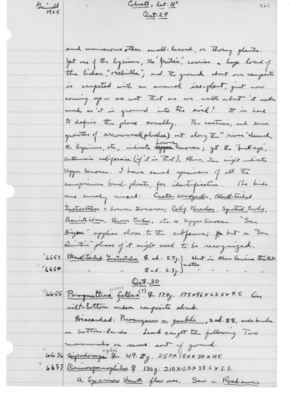Pages That Mention Peromyscus m. gambeli
1925: Joseph Grinnell's field notes
S3 Page 67
Collector: Grinnell - 1925 Location: Colnett, Sat. 31 degrees Date: October 28, 1925 ?Page Number: 2609
on agave hillsides, where they live in closest association with the intermedia wood rats.
6643 Black-Tailed Gnatcatcher (female sign) ad. 5.8g. Shot in artemesia californica (?) bush. 6644 Western Gnatcatcher (male sign) ad. 5.6g. Shot in sumach bush.
Barometer tonight 29.85 inches; warm, muggy; high fog all day. One perspires too freely for comfort. 7 p.m. - Writing by light of of burning agaves- dead ones, of which there are many on the hillside above our camp. Just went the rounds of my traps by flash light - one Perognathus and one Peromyscus, only, so far. Had re-set Dipodomys traps at fresh burrows, but untouched; maybe these rats do not come out so early, altho it was quite dark by 5:30. Saw a Black Phoebe late this evening. The Western Gnatcatcher taken is the only one of that species so far noted here. The Black-Tailed Gnatcatcher is fairly common, but I find them hard to see by reason of their dark colors, much harder than the other species. The black-tails keep nearer the ground, among the dark stems in the thick brush-clumps. They have two kinds of notes, the faint nasal mew, and a louder, repeated che-che-che-che; so I was right (p. 2593).
Oct. 29 Discarded: Peromyscus m. gambeli, (female sign) (4 emb.), 2 small blue pelaged males, all under composite bushes out on bottomland. 6645 Perognathus arenarius (male symbol) 9.7g. 142 x 71 x 20 x 5. Same trap as yesterday’s. 6646 Black-Tailed Gnatcatcher (male symbol) 5.8g. Shot in Rhus laurina bush.
S3 Page 69
Collector: Grinnell - 1925 Location: Colnett, lat. 31 degrees Date: October 29, 1925 Page Number: 2611
and numerous other small-leaved, or thorny plants. Yet one of the lyciums, the “frutéa,” carries a huge load of the lichen, “orchilla”; and the ground about hour campsite is carpeted with an annual ice-plant, just now coming up - so wet that as we walk about it makes mud as it is ground into the soil! It is hard to define the place zonally. The cactus, and dense growths of arrowweed (pluchea) out along the “river” channel, the lyciums, etc., indicate Lower Sonoran; yet the “buck-eye”, artemisia californica (if it is that), Rhus, etc., might indicate Upper Sonoran. I have saved specimens of all the conspicuous bush plants, for identification. The birds are surely mixed: Cactus Woodpecker, Black-Tailed Gnatcatcher = Lower Sonoran; Calif. Thrasher, Spotted Towhee, Bewick Wren, Brown Towhee, etc. = Upper Sonoran. “San Diegan” applies close to the sub fauna; but a “San Quentin” phase of it might need to be recognized.
6653 Black-Tailed Gnatcatcher (female sign) ad. 5.7g. 6654 “ “ (male sign) ad. 6.3g. Shot in Rhus laurina thickets. mates.
Oct. 30 6655 Perognathus fallax (?) (female sign) 17.4g. 175 x 96 x 23.5 x 4.5 On silt-bottom under composite shrub. Discarded: Peromyscus m. gambeli, 2 ad. (male sign) (male sign), under bushes on bottomlands. Lamb caught the following two mammals on same sort of ground. 6656 Dipodomys agilis (female sign) 49.2g. 257 x 150 x 38 x 115. 6657 Ammospermophilus (female sign) 130g. 210 x 53 x 38.5 x 5.5. A Sparrow Hawk flew over. Saw a Roadrunner

